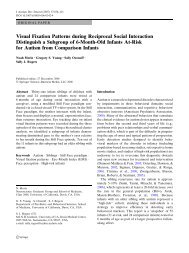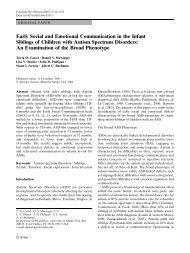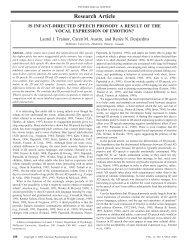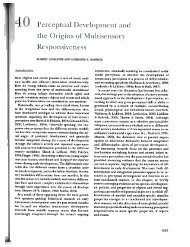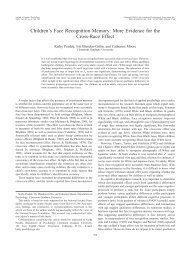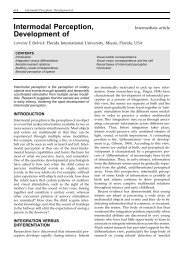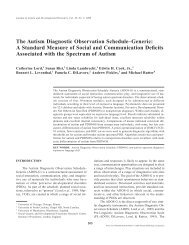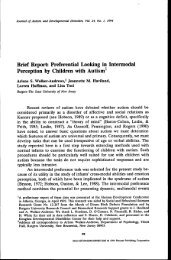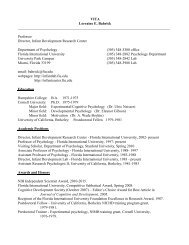The role of the mother's voice in developing mother's ... - FIU Infant Lab
The role of the mother's voice in developing mother's ... - FIU Infant Lab
The role of the mother's voice in developing mother's ... - FIU Infant Lab
You also want an ePaper? Increase the reach of your titles
YUMPU automatically turns print PDFs into web optimized ePapers that Google loves.
30<br />
F. Z. Sai<br />
stranger’s face from 4, 12, 72 and 78 h, respectively. Us<strong>in</strong>g a high amplitude<br />
suck<strong>in</strong>g (HAS) technique, Walton et al. (1992) reported that <strong>in</strong>fants from 12 h <strong>of</strong><br />
age produced more suck<strong>in</strong>g responses to <strong>the</strong> videotaped image <strong>of</strong> <strong>the</strong>ir mo<strong>the</strong>r’s<br />
face than that <strong>of</strong> a female stranger.<br />
Not only do neonates prefer to look at a composite <strong>of</strong> previously seen faces<br />
than at a composite <strong>of</strong> previously unseen faces (Walton and Bower, 1993), but can<br />
recognize a learned face over transformations (Walton et al., 1997), and even learn<br />
an image similar to a composite <strong>of</strong> <strong>the</strong> faces <strong>the</strong>y have seen <strong>in</strong> <strong>the</strong> first hours <strong>of</strong><br />
birth (Slater et al., 1998). Altoge<strong>the</strong>r <strong>the</strong>se data suggest a rapid learn<strong>in</strong>g about<br />
faces with<strong>in</strong> <strong>the</strong> first hours <strong>of</strong> birth, and <strong>the</strong> establishment <strong>of</strong>}at least}a<br />
rudimentary representation <strong>of</strong> faces. None<strong>the</strong>less <strong>the</strong> basis <strong>of</strong> such learn<strong>in</strong>g and<br />
what is be<strong>in</strong>g learned rema<strong>in</strong>s obscure.<br />
<strong>The</strong>re has been more than one <strong>in</strong>terpretation <strong>of</strong>fered to expla<strong>in</strong> <strong>the</strong> data<br />
suggest<strong>in</strong>g early preference, such that <strong>the</strong>re exists a configurational response <strong>in</strong><br />
<strong>the</strong> neonatal period. Goren et al. (1975) and Dziurawiec (1987) reported that<br />
<strong>in</strong>fants only m<strong>in</strong>utes old oriented <strong>the</strong>ir heads to follow a two-dimensional<br />
schematic face-like pattern than ei<strong>the</strong>r <strong>of</strong> two patterns consist<strong>in</strong>g <strong>of</strong> <strong>the</strong> same<br />
facial features <strong>in</strong> different arrangements. Johnson and Morton (1991) who<br />
replicated Goren et al.’s study proposed <strong>the</strong> existence <strong>of</strong> ‘Conspec’. Consist<strong>in</strong>g <strong>of</strong><br />
three dots, <strong>the</strong> Conspec serves to direct <strong>the</strong> newborn’s visual attention to faces.<br />
While this proposition seems plausible, <strong>the</strong>re are some data that are not easily<br />
expla<strong>in</strong>ed (e.g. Turati et al.’s (2002) results). Preference for <strong>the</strong> mo<strong>the</strong>r’s live face<br />
vanished with <strong>the</strong> slightest orientation, half-pr<strong>of</strong>ile <strong>of</strong> that face (Sai, 1990), and<br />
when hair-face l<strong>in</strong>e <strong>in</strong>formation was masked (Pascalis et al., 1995). Recognition <strong>of</strong><br />
<strong>the</strong> half-pr<strong>of</strong>ile pose <strong>of</strong> <strong>the</strong> mo<strong>the</strong>r’s face was, however, possible only at 4–5<br />
weeks from birth (Sai and Bushnell, 1988), and it was only at 10–12 weeks that<br />
<strong>in</strong>fants demonstrated preference for <strong>the</strong> mo<strong>the</strong>r’s face shown <strong>in</strong> pr<strong>of</strong>ile (Sai,<br />
1990). Toge<strong>the</strong>r, <strong>the</strong>se f<strong>in</strong>d<strong>in</strong>gs seem to favour <strong>the</strong> learn<strong>in</strong>g hypo<strong>the</strong>sis; it Is<br />
possible that <strong>the</strong> <strong>in</strong>fants had not been sufficiently exposed to <strong>the</strong> half-pr<strong>of</strong>ile and<br />
pr<strong>of</strong>ile poses <strong>of</strong> <strong>the</strong>ir mo<strong>the</strong>r’s face. If recognition is based solely on facial<br />
configuration, <strong>the</strong>n <strong>in</strong>fants should have been able to show preference for <strong>the</strong><br />
mo<strong>the</strong>r’s face s<strong>in</strong>ce at least some <strong>in</strong>formation about facial configuration was still<br />
available, at least <strong>in</strong> <strong>the</strong> half-pr<strong>of</strong>ile pose.<br />
It is fairly clear <strong>in</strong> retrospect that <strong>the</strong>re were some methodological shortcom<strong>in</strong>gs<br />
with <strong>the</strong> studies that used real faces. For example Field et al.’s (1984)<br />
study failed to take <strong>the</strong> olfactory <strong>in</strong>formation <strong>in</strong>to account. Those which<br />
controlled for discrim<strong>in</strong>ation on <strong>the</strong> basis <strong>of</strong> olfactory <strong>in</strong>formation, implemented<br />
a control over <strong>the</strong> mo<strong>the</strong>r’s and stranger’s odours only dur<strong>in</strong>g <strong>the</strong> test<strong>in</strong>g (Sai,<br />
1990; Bushnell et al., 1989) and, so was <strong>the</strong> mo<strong>the</strong>r’s <strong>voice</strong>. Never<strong>the</strong>less, exposure<br />
to <strong>the</strong> mo<strong>the</strong>r’s <strong>voice</strong>–face from birth to <strong>the</strong> time <strong>of</strong> test<strong>in</strong>g might have facilitated<br />
learn<strong>in</strong>g <strong>the</strong> mo<strong>the</strong>r’s visual features. Evidence suggests learn<strong>in</strong>g <strong>of</strong> <strong>the</strong> mo<strong>the</strong>r’s<br />
<strong>voice</strong> at birth. For example, <strong>in</strong> a study by DeCasper and Fifer (1980), 2–4-day-old<br />
neonates preferred <strong>the</strong>ir mo<strong>the</strong>r’s <strong>voice</strong>. Moon et al. (1991) demonstrated that<br />
with both Spanish and English speak<strong>in</strong>g women, 2-day-old newborns preferred<br />
<strong>the</strong>ir mo<strong>the</strong>r’s language.<br />
<strong>The</strong>refore, <strong>the</strong> question <strong>of</strong> controll<strong>in</strong>g for <strong>the</strong> mo<strong>the</strong>r’s <strong>voice</strong> is, particularly<br />
critical for understand<strong>in</strong>g <strong>the</strong> mechanism underly<strong>in</strong>g preference for <strong>the</strong> mo<strong>the</strong>r’s<br />
face at birth. <strong>The</strong> mo<strong>the</strong>r’s face, like many o<strong>the</strong>r stimuli we experience is<br />
<strong>in</strong>termodal <strong>in</strong> that it provides <strong>in</strong>formation to more than one sensory modality. For<br />
example, dur<strong>in</strong>g <strong>in</strong>teraction with <strong>the</strong> mo<strong>the</strong>r, <strong>in</strong>fants are provided with tactile<br />
stimulation, warmth and exposure to <strong>the</strong> mo<strong>the</strong>r’s <strong>voice</strong>, odours, taste <strong>of</strong> her<br />
milk and even to <strong>the</strong> rhythms to her heart beats. This wide range <strong>of</strong> <strong>in</strong>formation<br />
Copyright # 2004 John Wiley & Sons, Ltd. Inf. Child Dev. 14: 29–50 (2005)



